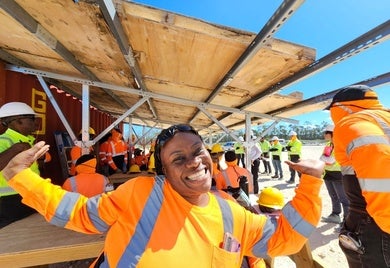Blogs Navigation
Sustainable BusinessRecent posts

Latin America and the Caribbean at the forefront of energy and technological progress
The region is rich in essential minerals and has the potential to develop its value chains. Countries must overcome several challenges to take advantage of these resources and their benefits. This requires transparency, governance, and attracting private investment.

We Helped a Solar Plant Hire More Women. Will the Industry Follow Suit?
The Lucayas Solar Power Project in the Bahamas marked a milestone by pioneering the integration of women in the construction of solar photovoltaic plants. What we learned in the process can help other companies’ commitment to gender equity.

Overcoming Three Challenges to Unlock the Potential of Green Hydrogen
Several countries in Latin America and the Caribbean have an adequate renewable energy generation capacity, abundant water resources and other favorable conditions to diversify the power generation matrices and decarbonize energy-intensive industrial segments. Breaking down legal, regulatory, financial, technical and market barriers can help them lead the charge on clean energy initiatives.

Investing in water and sanitation is no dirty business
In an era of smart cities, 3D printing and artificial intelligence, The Economist awarded the “humble loo” the world’s greatest innovation. Why? It has saved the lives of billions. The World Health Organization concluded that one dollar spent on sanitation generates a return of $5.50. In Latin America the return climbs over $7.00 – the second highest after East Asia. When people are healthier, productivity improves and attrition and absenteeism decline.

What does paternity leave have to do with a company’s success?
Companies in Latin America cannot find the human talent they’re looking for. An international survey of 41,000 companies found that more than 60% of employers in countries like Brazil and Peru have problems filling vacancies. In Costa Rica, more than 45% of the companies surveyed are dealing with this—they simply cannot find the right people.

Five lessons from the expansion of the Panama Canal
By Rachel Robboy Many aspects of the Panama Canal expansion make it stand out. The 7-year project to add a third lane to accommodate giant ships with triple the cargo capacity is the largest infrastructure project in Latin America and the Caribbean, costing over $5 billion. It brings in 22 percent of Panama’s national gross domestic product, allowing the country to grow at 6 percent in a year when the rest of the region is slowing down.

Why is there growing demand for Central American cocoa?
In pre-Columbian times, cocoa was a commodity so valuable it was used as a currency. In Mesoamerica, where it has been consumed for millennia, the Aztecs paid for everyday items in cocoa beans. Three would buy you a turkey egg, one hundred a whole hen.

Why does the private sector need capital markets?
Across emerging markets, access to finance is one of the largest barriers to success for private enterprises. Business leaders cite scarcity of credit as their main concern for growth, outweighing issues like corruption, tax and political instability.

How cattle ranchers can profit from planting trees
In agriculture it’s not often that you find a relatively simple way to increase production by up to 20%. Planting trees turns out to be one such way for cattle farmers. Cows like shade and grow much faster if they graze on pastures dotted with trees. Studies show that combining livestock herding and forestry on the same stretch of land can lead to an 8% to 20% increase in dairy and meat production in the Southern Cone region.


